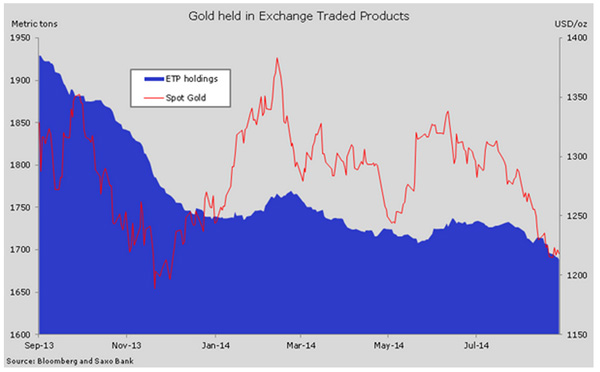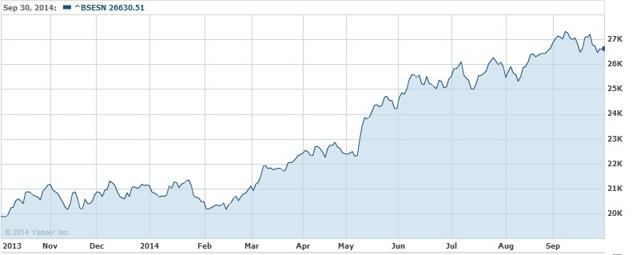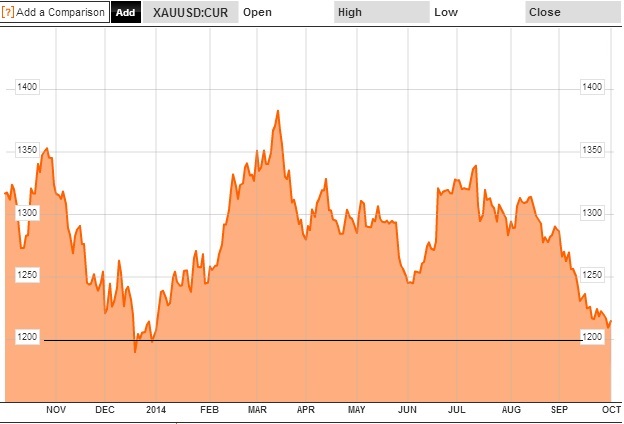Gold Breaches Key Support Level
Oct. 4, 2014 7:48 AM ET
Summary
- Gold holdings in exchange traded funds are at a five-year low.
- The Indian government may not cut import duty on gold in the near term. Indian equities provide a better investment option to domestic investors compared to gold.
- The steam provided by geopolitical events is diminishing.
- The U.S. economic indicators improve.
- Gold price breaks key support level of $1,200 per troy ounce.

Source: Mining.com
The third quarter of 2014 is the sixth quarter in a row that saw a reduction in holdings in global exchange traded funds backed by physical gold. The gold holdings are now at a five-year low of 1,688 tonnes, about 36% below the December 2012 levels of 2,632 tonnes.
Indian demand
The Indian festival season has begun which will lead to uptick in gold jewelry purchases. India may import 80 tonnes of gold in the current month. According to the Indian Bullion and Jewellers Association, gold imports in the country will rise from current average of 50 to 60 tonnes per month to about 70 to 75 tonnes per month. Assuming India imports 75 tonnes of gold per month, then annual gold imports cannot exceed 900 tonnes per year. Even in the best case scenario, gold imports will be below 2013 levels when India imported 974.8 tonnes of gold.
India's foreign exchange reserves stand at $315.59 billion, sufficient to cover less than eight months of imports. India is expected to become an iron ore importer, which will increase the country's import bill by $3.55 billion over the next three years. The recent judgment by the Supreme Court of India on cancellation of 214 coal blocks will increase India's import bill by another $3 billion. In the near term, it is unlikely that the Indian government will reduce the 10% import duty on gold, as it will increase India's import bill further and affect the country's foreign exchange reserves.
(click to enlarge)

Source: Yahoo Finance
The National Democratic Alliance has a strong majority in the Indian Parliament for taking economic reforms. India's GDP growth rate for FY 2014/15 (April 2014 to March 2015) is forecasted to be 5.6%. The Sensex, India's benchmark index, has rallied over 30% in the last one year. According to Citigroup, the Sensex will touch 31,000 by December 2015, which means a return of 16% over a period of 15 months. This target is achievable and it will motivate domestic investors to invest in Indian equities rather than investing in gold. Hence, the Indian gold demand is unlikely to attain the 2013 levels.
Gold prices

Source: Bloomberg
The Federal Reserve's quantitative easing program ends this month. Gold rallied several times in 2014 fueled by geopolitical events, including the Russia-Ukraine conflict and the Middle East crisis.
The U.S.-led airstrikes are targeting the ISIS controlled areas in the Middle East. Last month, the European Union and the U.S. imposed new sanctions on Russia that target Russian officials as well as the Russian oil industry, defense firms and banks. The geopolitical risk to the global economy still persists. However, gold prices have declined over 5% since September 2014. Gold traded within a narrow range of $1,200 to $1,400 since the beginning of the year.
Yesterday, gold prices breached the key support level of $1,200, as the U.S. economy added 248,000 jobs last month, while the unemployment rate fell to 5.9%. September 2014 is the 48th month in a row of positive job growth. The U.S. dollar index reached a high of 86.74 on account of the positive economic data. The improvement in the health of the U.S. economy also increases the likelihood of interest rate hike, which is a bearish indicator for gold prices.
Final Thoughts
The investment sentiment for gold is low. The steam provided by geopolitical events in 2014 appears to be diminishing. I recommend investors to sell gold, as it broke the key support level of $1,200 per troy ounce.

0 comments:
Publicar un comentario